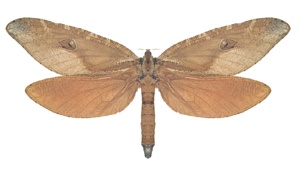
The Hepialidae are a family of insects in the lepidopteran order. Moths of this family are often referred to as swift moths or ghost moths.

Cladoxycanus is a monotypic genus of moths belonging to the family Hepialidae. It consists of only one species, Cladoxycanus minos, which is endemic to New Zealand. C. minos was first described by George Hudson in 1905.

Eudalaca is a genus of moths of the family Hepialidae. There are 35 described species, most restricted to South Africa but a few found further north in the continent.
Neohepialiscus is a monotypic moth genus of the family Hepialidae. The only described species is N. algeriensis of Algeria and Tunisia.
Parahepialiscus is a monotypic moth genus of the family Hepialidae. The only described species is P. borneensis of Borneo.
Phialuse is a monotypic moth genus of the family Hepialidae. The only described species is P. palmar of Bolivia.
Puermytrans is a monotypic moth genus of the family Hepialidae. The only described species is P. chiliensis of Chile.
Schausiana is a monotypic moth genus of the family Hepialidae described by Pierre Viette in 1950. The only described species is Schausiana trojesa, described by William Schaus in 1901, which is endemic to Mexico.
Xhoaphryx is a monotypic moth genus of the family Hepialidae. The only described species is X. lemeei of Vietnam.

Zelotypia is a monotypic moth genus of the family Hepialidae. The only described species is Z. stacyi, the bentwing ghost moth, which is only found in Queensland and New South Wales, Australia. This is a very large species with a wingspan of up to 250 mm. The larva feeds and pupates in the trunks and branches of Eucalyptus.
Callipielus salasi is a species of moth of the family Hepialidae. It was discovered in Temuco, Chile at the Carillanca Experimental Station. It was discovered and named by Gaden Sutherland Robinson in his 1977 publication "A Taxonomic Revision of the Genus Callipielus" and readdressed in his 1983 publication "Ghost Moths of South America".

Dioxycanus oreas is a species of moth of the family Hepialidae. It is endemic to New Zealand. It was first described by George Vernon Hudson in 1920. The species was discovered by Averil Lysaght.
Phassus pharus is a moth of the family Hepialidae first described by Herbert Druce in 1887. It is known from Guatemala. Food plants for this species include Malvaceae and grasses such as sugar cane.

Sthenopis pretiosus, the gold-spotted ghost moth, is a species of moth of the family Hepialidae. It was first described by Gottlieb August Wilhelm Herrich-Schäffer in 1856. It can be found in found Brazil, Venezuela and in the eastern United States and south-eastern Canada.
Thitarodes danieli is a species of moth of the family Hepialidae. It was described by Pierre Viette in 1968, and is known from Nepal.
Thitarodes dierli is a species of moth of the family Hepialidae. It was described by Pierre Viette in 1968, and is known from Nepal.
Thitarodes nipponensis is a species of moth of the family Hepialidae. It was described by Kyoichiro Ueda in 1995, and is known from Japan.
Thitarodes eberti is a species of moth of the family Hepialidae. It was described by Pierre Viette in 1968, and is known from Nepal.
Parahepialus is a monotypic moth genus in the family Hepialidae described by Zhi-Wen Zou, Xin Liu and Gu-Ren Zhang in 2010. Its only species, Parahepialus nebulosus, was described by Sergei Alphéraky in 1889 and is known from the Tibet Autonomous Region in China.

Wiseana copularis is a species of moth belonging to the family Hepialidae. It is endemic to New Zealand. This moth is one of several very similar looking species within the genus Wiseana and this group are collectively referred to as "Porina" moths. In its larvae form this species consumes pasture grasses and, if numerous, is regarded as a pest by New Zealand farmers reliant on good quality pasture for their stock.







